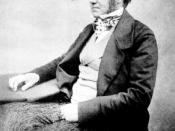Alex Rosenberg begins his Lessons from Biology for the Philosophy of the Human Sciences with the argument that social sciences ought to be regarded as biological ones. In taking this approach he is confident that most of the social sciences are satisfying the business of ÃÂexplaining and predicting human affairsÃÂ (4). Using the term ÃÂhuman sciencesÃÂ Rosenberg embraces all social sciences under one umbrella while creating a term which easily locates his view about how biology allows one to appreciate the attractive and restrictive nature of value-based branches of knowledge. Rosenberg further emphasizes that improved understanding of the biological realm and biology as a science will help find a solution to numerous outstanding issues resulting from the philosophy of social science. Solving these problems hardly alters most of the human sciences but provides an improved understanding of their limits, scope, and methods (3).
Rosenberg asserts that biology is a historical science that only stands in the presence of strong historical backing.
It is ÃÂalmostÃÂ completely a historical science (6). This is because history tends to address past phenomena on biological systems over the past 3.5 - 5 billion years (5). For example, Rosenberg reminds us of the extinction of various flora and fauna that can only be explained with a historical perspective (5). There is a constant need to refer to particular regions, places and times that ever existed in the annals of this universe when describing the past. BiologyÃÂs historical character is even more evident in the taxonomy of any given biological system. Biological sense can only be found when considering Charles DarwinÃÂs findings and more specifically against the background of his theory of evolution. Systematically dividing species into kinds and categories laid the historical character of biology. Rosenberg examines the philosophical problem biologists have when trying to explain particular events or historical patterns in contrast with ÃÂnonhistorical scienceÃÂ (chemistry, physics, etc.) (5) that do not. He asserts that nothing in the biological sciences can make sense without knowledge gained from Darwinian theories on variation, adaptation and natural selection (5). Furthermore, biology borrows much from the human sciences leading to a merger that leaves no clear boundary. Biology can never exist on its own, and without the social science like history, there is no purely biological explanations that can adequately uphold it.
In evaluating the absence of laws in biological sciences, Rosenberg suggests that we cannot identify laws in biology without asserting that ÃÂkindsÃÂ are a result of adaptive variation and natural selection; where improbability makes laws regarding ÃÂfunctional kindsÃÂ improbable. Rosenberg suggests that description and classification within biology and human sciences has the potential for creating laws. Moreover, the only law in human sciences is also the one and only law that biological ÃÂtruthsÃÂ are based upon: the Darwinian law of natural selection (7). Rosenberg further explains that the law of natural selection not only serves in selection of various genetically encoded traits but also helps in the selection of epigenetic traits; very many of which are of significance in the understanding of human sciences (7). This leads Rosenberg to the fact that solving one species design problem leads to a new design problem in anther (8). Of importance among these epigenetic traits is the culturally encoded traits (adaptiveness, behaviors and institutions) which are also important in the understanding of many human sciences (7, 9). According to Rosenberg, various genetic laws in biology are therefore but a first approximation of modifications on genes within stable environmental settings over a wide range of time (9).
Regarding various ÃÂdesign problemsÃÂ set by nature Rosenberg explains that the lineages of creatures on Earth are constantly equipped with relevant structures to promote survival of the fittest (8). The biologist and their human science counterparts are only left with a similar task of identifying these design problems and give explanations and conclusions for how conditions should be applied. While the biologists dig deep into each story of adaptation in search of evidence and explanation of how design issues are solved, the human sciences seek to explain the meaning of the resulting behavior; identifying the behavior as an action in of itself (10).
Rosenberg states that if biology is to be regarded as historical in nature then it follows that all biological theories and explanations are narrative just as all human activities are explained through narration (14). Human science explains events clearly and plainly concerning theories that establish their relevance. Interpretive human science, qualitative social science, hermeneutics, symbolic interaction, among others, all signify an approach to human behavior just as adaptationalism is to biology (15). Rosenberg argues that human beings are biological creatures and the just interpretation of this is adaptationalism gives a clear view on how biological and human sciences interrelate.
In conclusion, Rosenberg sees biology, in all senses, working hand in hand with human sciences in a bid to allow for definitions for various issues and phenomena occurring in our universe (17). Almost all biological principals find a deep or adequate explanation and meaning from the world of human sciences. The human sciences on the other hand have the obligation to explain various behavioral changes in the lives of organisms due to genetic modifications (16). Therefore, Rosenberg states the need to assert that all these disciplines have a common meeting point and the state at which they come into coherence. Biological sciences borrow much from the human sciences and the opposite is true. Thus, advancement and opportunities in the sciences will follow when investing resources and promoting research in biological science and adopting reductionist, top-down (construct-driven) approaches in human science (18, 19).
BibliographyRosenberg, A. (2005) Lessons from biology for philosophy of the human sciences. Sage Publishers.

